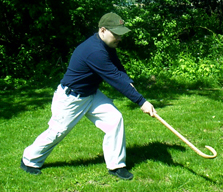its paid sponsors, whose products you need!
| Home |
| Intro |
| Current Issue |
|
Mailing List |
| Store |
| Strength |
| Subscriber Content |
| ARCHIVES
|
| Martialism |
| Pacifism |
| Q & A |
| Cunning-Hammery |
| Advertise With Us |
| Submit An Article |
| Staff |
| Discussion Forum |
| Links |
“Stay ‘unreasonable.’ If you
don’t like the solutions [available to you], come up with your
own.”
Dan Webre
The Martialist does not
constitute legal advice. It is for ENTERTAINMENT
PURPOSES ONLY.
Copyright © 2003-2004 Phil Elmore, all rights
reserved.
Cane Masters: Basic Foundation and
Street Techniques Videos
A Product Review by
Phil Elmore
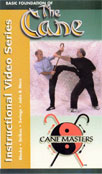 When
When
I reviewed the
Cane
Masters Triple Grip fighting cane at PhilElmore.com, I was very impressed
with the product. Well made, relatively innocuous,
generally legal, and remarkably versatile, the cane should be considered by
anyone seeking a self-defense tool that can be taken almost anywhere.
The cane is, up to a point, a fairly intuitive
instrument for delivering force. Those inclined to take a
simpler-is-better approach to self-defense will not need to go much farther
than what they can intuit. A crook-top cane is, after all, a big stick
with a hook on it. There are obvious applications of such a thing.
For those looking for more complex material,
the Cane Masters
instructional video line includes two tapes that complement each other.
These are the
Basic
Foundation and
Street
Techniques tapes, which I’m told are among their more popular products.
Both tapes feature Mark Shuey, Sr. and Mark
Shuey, Jr., while the Foundation video includes other members of the Cane
Masters team. The elder Shuey holds multiple black belts. The
canes his company produces are highly regarded and often coveted by those who
see the merits of this weapon.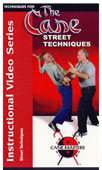
CANES FOR SELF-DEFENSE
My own experience with the cane came in June of
2002. Sparring outdoors on a broken plain of rock, I stepped into a
jagged hole. My ankle, though protected by a leather combat boot, was
horribly contused and swelled to almost three times its normal size.
Finding crutches bothersome and worried about
both my mobility and my self-defense prospects, I spoke with one of my
teachers about learning cane techniques. I had only a Walnut cane
purchased from a local drugstore, but it was enough to get me started.
Don Rearic’s
introductory article on the cane helped, too.
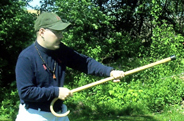 Eventually
Eventually
I bought my Cane Masters triple-grip and cannot imagine not owning one now. My
teacher Dave also
liked it quite a bit. While the cane techniques with which he is
familiar are not the same as those on the Cane Masters videos, the opportunity
to show him wielding the cane was too good to pass up — so I have included a
couple of photos here.
The tapes are for those interested primarily in
crook-top canes. Cane aficionados often debate the merits of crook-top
versus straight canes. Those favoring straight canes argue that they are
easier to use as weapons and hooking techniques are too complex or too slow to
be workable for self-defense. Crook-top fans counter that straight canes
are more likely to be viewed as illegal weapons, whereas crooked canes are
universally accepted. Fans of crooked canes also argue that hooking
techniques can work and are too useful to ignore completely.
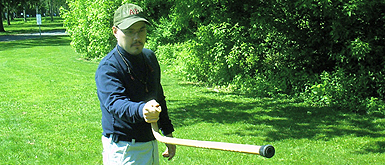
David W. Pearson puts the triple-grip
through its paces.
THE VIDEOS
My first impression of the videos was that the
cane style the Shueys advocate appears very Karate-influenced. Fans of
hard styles in this tradition may find this to their
benefit, feeling drawn to the material out of familiarity. There will be
those — FMA practitioners, for example — who would prefer to see greater
fluidity of movement.
Production values of the tapes are okay, with
some variation. Sound is a little quiet on the Foundation
video. The camera moves in and out as needed. There is light,
unobtrusive music in the background. The beige backdrop of the Foundation
video is more interesting than a blank white wall, but not distracting.
The Street Techniques video is filmed
outside in a very picturesque setting. The natural lighting is a bit too
conducive to shadow and there is some background noise from the environment,
which makes the sound inaudible at times.
The Foundation video begins by
describing the parts of a cane — the horn (the end of the curved part), crook
(the curved part), the shaft, and the tip (the rubber-capped end).
It continues with warm-ups, which are
stressed as being very important to avoid injury to muscles and tendons.
These include:
-
Back-and-forth twirling using the cane
-
Wrist and arm stretches (to prevent
tendonitis) -
Shoulder stretches using the cane
-
Side stretches while holding the cane above
the head -
Warm-up strikes
Many specific techniques are presented on the Basic Foundation tape. (As I indicated before,
some will find this complexity appealing, while others will think it
unworkable and reject it as offered.) If I have a complaint about the
“instructional design” of the tape, it is that the techniques are presented
too quickly. Rapidly listed and demonstrated on both sides of the body,
the moves are thrown at the viewer at a pace that may seem a little
overwhelming. One can compensate for this by viewing the tape (or
segments of it) more than once — this is a videotape, after all — but
slowing down the actual demonstrations would be helpful. There are
graphic titles displayed on the screen with the techniques, which helps
somewhat.
The techniques presented include the following,
demonstrated on both sides of the body. Footwork is integrated as
appropriate, with the admonition not to cross the feet. Punches are done
with full chambering of the off hand, as in Karate. The difference
between offensive and defensive techniques is that offensive techniques are
done stepping forward into the opponent, while defensive techniques are
performed stepping back and away from the opponent.
Blocks
-
Broom sweep block
-
Two-handed torso block
-
Two-handed diagonal high block
-
Two-handed low block
-
Two-handed high block
-
Two-handed brace block
-
Low striking block
-
Single-handed parry block
-
Downward fan block
-
Upward fan block
-
Single-handed post block
Punches
-
Horn-down punch
-
Horn-up punch
-
Vertical punch
-
Horizontal punch
Crook Strikes
-
Low crook strike
-
Mid-range crook strike
-
Groin strike
-
Head-level crook strike
-
Under-chin crook strike
-
Shoulder-level crook strike
-
Neck grab/face strike combination
-
Reverse neck grab forearm smash
Pokes
-
Defensive forward facing poke
-
Offensive forward facing poke
-
Offensive left side poke
-
Defensive left side poke
-
Offensive right side poke
-
Defensive right side poke
-
Back facing defensive poke
-
Back facing offensive poke
Swing Strikes
-
Offensive forward swing strike
-
Defensive forward swing strike
-
Offensive left side swing strike
-
Defensive left side swing strike
-
Offensive right side swing strike
(backhand) -
Defensive right side swing strike
(backhand) -
Offensive back swing strike (backhand)
-
Defensive back swing strike (backhand)
Strikes
-
Horizontal strike right to left, low-level
-
Horizontal strike left to right, low-level
-
Horizontal strike right to left, mid-level
-
Horizontal strike left to right, mid-level
-
Horizontal strike right to left, head-level
-
Horizontal strike left to right, head-level
-
Vertical strike upward
-
Vertical strike downward
-
Diagonal strike right to left, downward
-
Diagonal strike left to right, downward
-
Diagonal strike right to left, upward
-
Diagonal strike left to right, upward
Two-Handed Jabs
-
Offensive jab forward
-
Defensive jab forward
-
Offensive jab left side
-
Defensive jab left side
-
Offensive jab right side
-
Defensive jab right side
-
Defensive jab back side
-
Offensive jab back side
The tape concludes with demonstrations of
twirls and figure eights with the cane, intended to teach control.
Everything is done from the back of the head rolling forward. Figure
eights can be used as a warding technique, we are told.
Mark Shuey, Sr. asserts that when you
carry your cane, you should walk as if you don’t need it (unless you
do). Walk, he says, as if you have some style, occasionally twirling the
cane as you stroll. Do not look like a victim dependent on the cane, he
urges. He ends the Foundation video with the exhortation to practice.
The Street Techniques video applies some of
these numerous moves to what the Shueys consider practical self-defense.
The tape features both Mark, Sr. and Mark, Jr. (I thought it this was kind of
neat — a father and son who both study the same art and instruct others in
its use).
“The cane is one nasty tool,” we are
told. The Shueys assert that a 95 to 98 percent chance of death exists
when striking the head. They suggest that you start lower on the body
when defending yourself, working your way to the head if the situation
escalates. They also suggest, when asked why you carry a cane, to say
anything but “self-defense.”
While going to the attacker’s blind side — to
the outside — is preferable, moving to both the inside and the outside is
covered on Street Techniques. There are many techniques
demonstrated — a wide variety of strikes and combinations involving blocks,
hooking takedowns, pokes, jabs, and even kicks. The target, the Shueys
explain, is through the body. This is consistent with the Karate
influence I saw in the tapes.
In one typical sequence, for example, Mark Sr.
uses the crook and shaft, placed under Mark Jr.’s arm and behind the back of
his neck, to lever him to the ground. Not everything demonstrated is
quite that complicated, however. The response to a grab, for example,
could be as simple as whacking the attacker with the cane.
Defeating various chokes, grabs, and attacks
from behind are all covered in Street Techniques.
Knife defense is also
discussed on the Street Techniques video. Given the controversial
nature of such material, there will be those who love what is presented, those
who hate it, and those who don’t get terribly excited about it.
One technique demonstrated,
for example, involves striking the inside of the knife hand with the tip of
the cane, following up with the crook end to move into a takedown after a head
strike. The defender steps offline of the attack but to the opponent’s
inside.
Mark Jr. discusses knife
anatomy and explains that one must never use the inside of the arms to defend
against a knife. He also talks about distance and the advantage in
distance provided by the cane.
“Defanging the
snake” is demonstrated, striking the hand and wrist, then controlling
that hand as you counterstrike with the cane. Do not ever hesitate, the
Shueys warn.
Another technique
demonstrated is a defense against the classic “Norman Bates in Psycho”
overhead stab. The defender strikes and moves offline, counterattacking
with the crook of the cane. Do not be mild, we are told —
because a knife is lethal force, which justifies striking to the throat and
attacking other potentially fatal targets. Once your attacker is on the
ground, however, Mark Sr. advocates leaving him there. Do not
“overdo it.”
Blocks demonstrated are fan
blocks, using the cane for advantage. Parries and counterstrikes are
used to defeat thrusts. Mark Sr. also talks about controls and breaks
that can be done by using the crook of the cane around the neck. He
demonstrates a circular parry and follow-up taken into a neck hook
control/break (all while moving to the outside of the attacker).
The Shueys also demonstrate a
scenario in which a knife is held to the defender’s throat from behind.
Grabbing the hand and using the cane to pry it down, the defender follows-up
while still holding the knife hand.
“I hope and pray that
you will never get attacked with anything,” Mark Sr. explains.
“I hope you never have to use these canes for what I sell them
for.” He urges the viewers to avoid finding themselves wanting
a cane. Buy one and then carry it — and use it like you mean
it.
CANES AND YOU
Opinions of individual instructional videos are
always relatively subjective. The Cane Masters videos may be exactly
what you want when training with the cane, particularly if you study Karate,
or they may be totally unacceptable to you. The cane itself, however, is
a tool whose versatility you cannot afford to ignore.
In a world increasingly hostile to the
possession of defensive weaponry, the use of benign and accepted items like
canes for individual protection is something I advocate to everyone reading
this. Do yourself a favor and explore the Cane Masters products.
Don’t wait until you need a cane to
discover that you want one.
